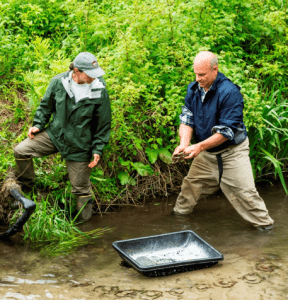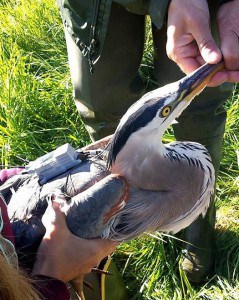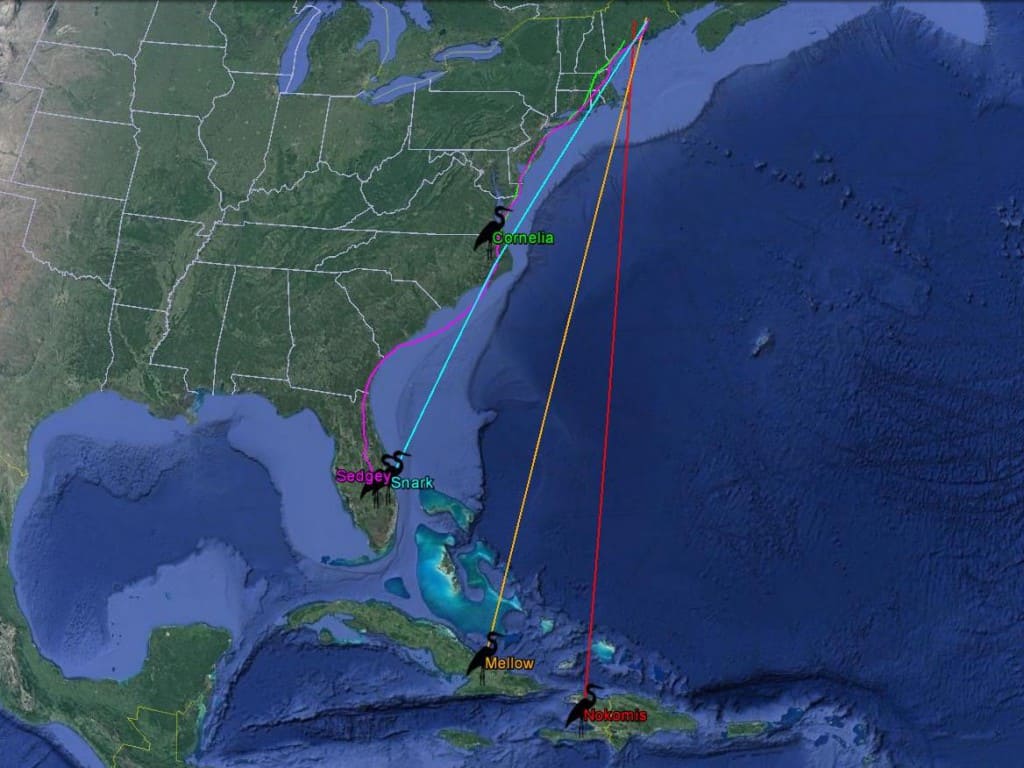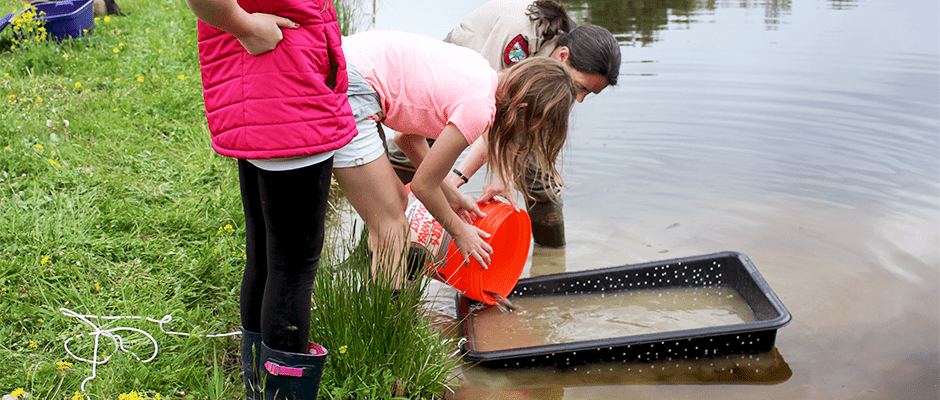Share this article
Heron tracking project: GPS data for all to use and learn from
This spring, MDIFW tagged five adult great blue herons with GPS transmitters as part of an ongoing effort to better understand the state’s great blue heron population. After a significant decline in the number of nesting pairs on Maine’s coastal islands from the 1980s to 2007, MDIFW listed the great blue heron as a Species of Special Concern and began a citizen science adopt-a-colony program called the Heron Observation Network. By marking and following individual adults over several years, MDIFW hopes to learn new information regarding daily movements, habitat use, colony fidelity, migration routes, and wintering locations of Maine’s herons.

Danielle D’Auria and John Brzorad set an array of modified foothold traps around a bait bit bin, hoping to capture a great blue heron. Photo by HERON volunteer, Joyce Love.
Students and teachers from schools across the state played an important role in the field work leading up to the tagging of the five herons. The students and teachers set and checked minnow traps, identified and measured the baitfish caught, and placed the baitfish into a bait bin in order to get a great blue heron to regularly feed from it. They also used game cameras to “watch” the bait bins when they were not there themselves. After a heron was accustomed to feeding from the bait bin, MDIFW and researchers Dr. John Brzorad (Lenoir-Rhyne University) and Dr. Alan Maccarone (Friends University) set out an array of modified foothold traps near the bait bin to capture the heron so they could tag it with a GPS transmitter. The use of modified foothold traps has been perfected by Brzorad, and involves watching the set traps from a blind until a heron steps into one of the traps. Once trapped, it is then quickly retrieved by the researchers for processing. The bird is kept calm with a hood over its eyes while researchers take measurements and a blood sample for sexing, and attach the transmitter.
The transmitters were purchased with help from a grant from the Maine Outdoor Heritage Fund, and represent the cutting edge of telemetry technology and transmit GPS locations via the cell phone network to an open source website (www.movebank.org). The units also collect xyz accelerometry data on behavioral postures that quantify time-energy budgets. Being solar-powered, they are expected to provide years of data for each tagged heron. Fully charged, the units collect 288 GPS points and 360 behavioral (accelerometry) tracings per 24-hr period. The data is available on www.movebank.org for the students, citizens, and conservationists of Maine to use in education and to help make conservation decisions.

“Mellow,” equipped with a GPS transmitter, just before release. ©Brittany Marinelli.
Brzorad and Maccarone have been using these same transmitters since 2013 and have paired nearly 20 birds (great egrets and great blue herons) with school systems in five other states. In Maine, the students involved in this spring’s field work ranged in level from grades 1-12 and were from the following schools: White Pine Programs in York, Harpswell Community School (in partnership with Harpswell Heritage Land Trust), Gray-New Gloucester High School, Nokomis High School in Newport, Old Town High School, Haworth Academic Center in Bangor, and Center Drive School in Orrington. Thanks to their efforts, five great blue herons were trapped and tagged in Orrington, New Gloucester, Orono, and Palmyra:
- “Sedgey” is a male trapped in Orrington, adopted by Center Drive School, and was named after the stream on which he was trapped: the Sedgeunkedunk. Sedgey’s summer movements showed he nested in a known great blue heron colony in Bradley, 11.85 miles (straight-line distance) from where he was trapped. Sedgey was the first of our tagged herons to fly south for the winter, beginning his journey on September 1st. He first stopped over at the Merrimack River estuary for 19 hours before flying nonstop for 29 hours to southern Georgia. Within 12 hours, he flew to an agricultural area north of Lake Okeechobee in Florida.
- “Cornelia” is a female trapped at the New Gloucester Fish Hatchery, adopted by the Gray-New Gloucester High School. She had gotten into a fish rearing raceway at the hatchery, making her an easy capture with a long-handled net. Cornelia’s summer movements showed she nested in a known great blue heron colony in Gray. Cornelia spent her post-breeding time in Brunswick and departed Maine on September 23rd. Unlike Sedgey, she stopped more frequently along her journey south to the Great Dismal Swamp area of Virginia and North Carolina. The last location received from her transmitter was on September 29th, which may be due to poor cell phone coverage there.
- “Snark” is a male trapped in Orrington and adopted by Haworth Academic Center in Bangor. The students chose his name because they had recently read Lewis Carroll’s poem, “Hunting of the Snark.” Snark’s summer movements showed he nested in a known great blue heron colony in Brewer. Volunteers verified Snark at a nest within this colony. The nest was one of the last ones to be active at the end of the season and on July 25th still had 1 young present. Snark’s transmitter temporarily stopped transmitting after September 22nd, possibly due to feathers covering the solar panel and preventing the battery to charge. We have since received locations revealing he is now wintering in Vero Beach, FL.
- “Mellow” is a female trapped at Pine Ponds on Orono Land Trust property and adopted by Old Town High School. Mellow’s summer movements showed she nested in a known great blue heron colony in Orono. Mellow’s transmitter temporarily stopped transmitting after October 13th. We have since received locations revealing she is now wintering in Puerto Padre, Cuba.
- “Nokomis” is a female trapped in Palmyra and adopted by Nokomis High School. Nokomis’ summer movements showed she nested in a known great blue heron colony in Newport, which is right behind the Nokomis High School baseball field. Nokomis’ transmitter temporarily stopped transmitting after September 2nd. We have since received locations revealing she is now wintering in rice plantations north of Saint-Marc, Haiti.

The current wintering locations of five great blue herons tagged with GPS transmitters in Maine in June 2016. Exact tracks for Snark, Mellow, and Nokomis are unknown due to low voltage of the transmitters during migration.
MDIFW is currently working to get more students involved in tracking the tagged great blue herons online and using the data generated by the solar-powered backpack transmitters in their classrooms. Students involved will not only learn something about great blue herons, but also make the connection that these birds rely on healthy wetlands, both in Maine and beyond.
For more information on the Heron Tracking Project, including how to follow the great blue herons once they are tagged and resources for educators interested in using the data in their classrooms, visit http://www.maine.gov/wordpress/ifwheron/tracking-project/.
Header Image: Students from Center Drive School in Orrington, dump bait fish into bait bin at a potential trap site. Photo by teacher, Nancy Swanson.








